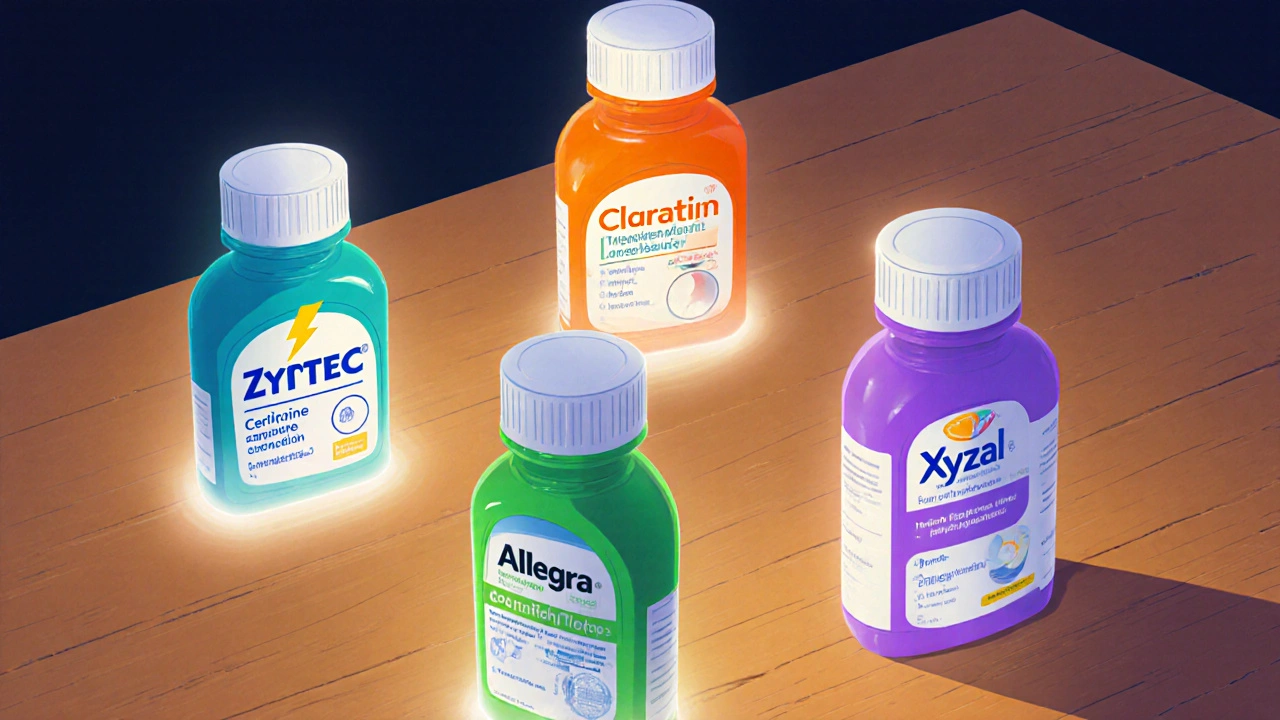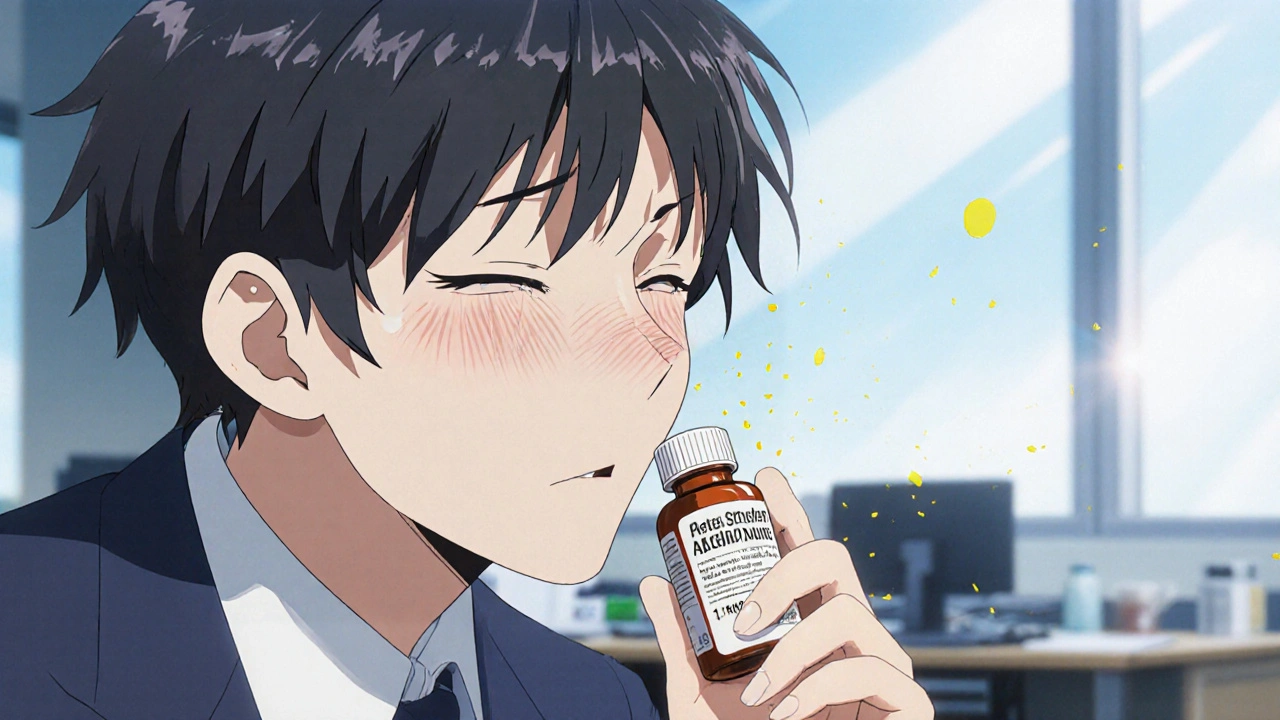Allergy Relief Selector
Find your ideal non-drowsy allergy medication based on your symptoms and lifestyle needs.
Select Your Priority
Your Recommended Option
Key Considerations
| Factor | Onset | Sedation Risk | Duration | Cost (90 pills) |
|---|---|---|---|---|
| Onset | ||||
| Sedation Risk | ||||
| Duration | ||||
| Cost |
Allergy season feels like a marathon you never signed up for-runny nose, itchy eyes, and that relentless sneezing. The annoying part? You need relief but can’t afford to feel drowsy at work or class. non‑drowsy antihistamine options promise exactly that, yet many people still wonder whether there’s a better fit for their lifestyle. This guide walks you through the science, the top over‑the‑counter choices, and practical alternatives when pills alone don’t cut it.
What makes a medication non‑drowsy antihistamine?
First‑generation antihistamines, like diphenhydramine (Benadryl), cross the blood‑brain barrier easily, which is why they make you sleepy. Second‑ and third‑generation drugs were chemically tweaked to stay out of the brain, so they block histamine receptors in the nose and eyes without knocking you out. The result is 24‑hour symptom control that doesn’t interfere with driving, operating machinery, or paying attention in a lecture.
OTC Leaders and Their Key Traits
Four names dominate U.S. pharmacy shelves: cetirizine, loratadine, fexofenadine, and levocetirizine. Below is a quick snapshot of each, followed by a side‑by‑side table that highlights onset, peak effect, duration, sedation risk, and price.
| Drug (Brand) | Onset | Peak Effect | Duration | Typical Sedation Rate | Average 90‑tablet Price (2024) |
|---|---|---|---|---|---|
| Cetirizine (Zyrtec) | Within 1 hour | 1 hour | 24 hours | 10‑15% report drowsiness | $10 (generic) |
| Loratadine (Claritin) | 1‑3 hours | 8‑12 hours | 24 hours | 5‑7% report drowsiness | $16 (brand) |
| Fexofenadine (Allegra) | 1 hour | 2‑3 hours | 12‑24 hours | <5% report drowsiness | $20 (brand) |
| Levocetirizine (Xyzal) | Rapid | 1‑2 hours | 24 hours | ~5% report drowsiness | $22 (brand) |
When a Pill Isn’t Enough: Alternative Strategies
Even the best‑tuned antihistamine can fall short for stubborn nasal congestion. Here are three non‑medication routes that work alongside or instead of a pill.
- Nasal corticosteroid sprays (e.g., Flonase, Nasacort) shrink inflamed tissue and often out‑perform antihistamines for congestion. They’re safe for daily use and start showing effect within a few days.
- Saline irrigation with a neti pot or squeeze bottle rinses out allergens and mucus, giving immediate relief without any drug‑related side effects.
- Air purifier with HEPA filter reduces airborne pollen and pet dander, lowering overall symptom load.
Mixing these approaches with a non‑drowsy antihistamine creates a layered defense that many allergy sufferers swear by.

Combination Products: Speed vs. Side Effects
Some brands add pseudoephedrine (a decongestant) to their antihistamine-think Zyrtec‑D or Claritin‑D. The added ingredient can relieve a blocked nose within minutes, but it also raises heart rate and blood pressure. If you have hypertension, heart disease, or are pregnant, stick with the single‑antihistamine formulas and consider a nasal spray for the congestion instead.
Cost‑Saving Tips You Might Not Know
Price gaps are real: a 90‑tablet pack of generic cetirizine can be $10, while brand‑name Allegra tops out near $20. GoodRx and pharmacy discount programs often shave 30‑80% off brand prices. Buying in bulk (180‑tablet bottles) drops the per‑dose cost further, and many insurance plans cover generic versions for free.

Choosing the Right Option for Your Lifestyle
Here’s a quick decision flow you can run through in your head or on paper:
- Do you need ultra‑fast relief? If yes, try cetirizine for its 1‑hour onset, or a combination product for a nasal “unblock” boost.
- Are you sensitive to any drowsiness? Choose fexofenadine (Allegra) or levocetirizine (Xyzal) - they have the lowest sedation rates.
- Do you regularly drink grapefruit, orange, or apple juice? Avoid fexofenadine with those juices; water is the safest carrier.
- Is cost a major factor? Generic cetirizine or loratadine are the most budget‑friendly.
- Is nasal congestion your biggest problem? Pair any non‑drowsy antihistamine with a nasal corticosteroid spray for best results.
Testing a couple of options over a week each is the safest way to discover your personal sweet spot.
Quick Checklist Before You Shop
- Check the label for “non‑drowsy” and “24‑hour relief.”
- Note any food‑drug interactions (e.g., avoid citrus with fexofenadine).
- Compare generic vs. brand prices using a price‑comparison tool.
- Decide if you need a decongestant boost; if not, stay with single‑antihistamine.
- Consider adding a nasal spray or saline rinse for stubborn congestion.
Frequently Asked Questions
Can I take a non‑drowsy antihistamine every day?
Yes. All FDA‑approved OTC options are safe for daily use in adults and children over 2 years, as long as you follow the dosing instructions.
Why do some people still feel sleepy on Zyrtec?
Cetirizine crosses the blood‑brain barrier a bit more than loratadine or fexofenadine, so a minority (about 10‑15%) notice mild drowsiness, especially at higher doses.
Is it safe to mix an antihistamine with a nasal steroid?
Absolutely. The two work on different pathways-one blocks histamine, the other reduces inflammation-so they complement each other without added risk.
Do I need to avoid alcohol while taking a non‑drowsy antihistamine?
Moderate alcohol isn’t a major issue, but heavy drinking can increase drowsiness, especially with cetirizine. It’s safest to limit intake.
What’s the best option for someone who can’t take decongestants?
Fexofenadine (Allegra) or levocetirizine (Xyzal) are low‑sedation choices that don’t contain pseudoephedrine, making them safe for hypertension or heart‑sensitive users.
Bottom line: non‑drowsy antihistamines give you the freedom to breathe easy without the fog. Pair the right pill with a spray, a rinse, or an air filter, and you’ll stay sharp all season long.



8 Comments
Dahmir Dennis October 24, 2025 AT 16:43
Oh, the joy of discovering yet another sparkling example of modern medicine’s relentless quest to keep us both sneezy and productive. You'd think after decades of research we could finally graduate from the archaic first‑generation antihistamines that lull you into a coma faster than a Netflix binge. Instead, we are handed a menagerie of second‑ and third‑generation pills that proudly wear the badge of "non‑drowsy" while secretly plotting to make us question our life choices. Let’s start with cetirizine, the beloved Zyrtec, which boasts a 10‑15% sedation rate-yes, you read that right, a whole ten percent of the population will still feel like they need a nap after a single dose. Then there’s loratadine, Claritin, the supposed hero that promises only a 5‑7% chance of drowsiness, but somehow still manages to make you stare blankly at spreadsheets for hours on end. Fexofenadine, the Allegra, claims less than five percent sedation, yet many users report a subtle fog that makes coffee taste like regret. Levocetirizine, the Xyzal, sits at roughly five percent, the perfect middle ground if you enjoy the occasional yawning fit. The differences in onset, peak effect, and duration are trivial compared to the existential dread of choosing a pill that might just sabotage your day. And let’s not ignore the delightful combination products that slap pseudoephedrine on the side, because nothing says "I care about your health" like raising your blood pressure while you try to breathe. If you’re inclined to spend a fortune, the brand‑name versions sit proudly between $16 and $22, a price point that screams, "I have a mortgage and still need to pick a nose." Meanwhile, the generic alternatives lurk in the pharmacy aisles for a modest $10, as if to remind you that capitalism can be kind when it wants to be. Saline irrigation and nasal sprays are touted as “alternatives,” but of course, nobody can resist the allure of a shiny new bottle promising relief without side effects. The bottom line, dear reader, is that the world of non‑drowsy antihistamines is a labyrinth of marketing jargon, subtle sedative threats, and price gouging that will keep you busy all season long while you chase the ever‑elusive perfect sneeze‑free existence. So go ahead, test each option for a week, and enjoy the grand adventure of becoming intimately familiar with every label, warning, and hidden clause. In the end, you’ll either find the perfect match or develop a newfound appreciation for the simple pleasure of just… not sneezing.
Kester Strahan October 30, 2025 AT 19:07
Yo, gotta say the pharmacokinetic profiles listed here are pretty legit, but lemme drop some extra jargon for the nerds. The bioavailability of cetirizine hovers around 70%, while loratadine’s conversion to its active metabolite desloratadine is a first‑pass marvel. Fexo’s absorption is deterred by fruit juices, cause citrus compounds inhibit OATP transporters-so stick to H2O if you don’t want a dip in efficacy. Also, the half‑life of levocetirizine is roughly 8‑9 hours, making it a solid choice for those who need consistent plasma levels without the midday crash. In practice, I’ve seen a 1.2:1 ratio of nasal congestion relief when pairing any of these with a corticosteroid spray, so layering is defo the way to go.
Just a heads‑up: the decongestant combos can trigger tachycardia via alpha‑adrenergic stimulation, especially in hypertensive patients.
HILDA GONZALEZ SARAVIA November 5, 2025 AT 21:31
Happy to add a bit of practical advice for anyone trying to figure out which non‑drowsy antihistamine fits their daily routine. If you’re a college student pulling all‑nighters, cetirizine’s quick onset (within an hour) can be a lifesaver, but be mindful of that 10‑15% drowsiness rate-maybe keep a coffee handy. For office workers who need a consistent 24‑hour shield without any brain fog, loratadine is a solid bet, especially since it’s less likely to interact with common over‑the‑counter meds. Those who are sensitive to caffeine or have a history of insomnia might gravitate toward fexofenadine, as it has the lowest sedation profile, but remember to avoid grapefruit or orange juice when you take it. Levocetirizine works well for people who experience breakthrough symptoms later in the day because its peak effect hits faster than loratadine. Don’t forget that generic versions are bioequivalent, so you can save a bundle without sacrificing efficacy. Pair any of these with a daily saline rinse-just a quick “floss” for your nasal passages-to clear out pollen before the meds even get a chance to work. Lastly, keep an eye on the price‑comparison tools like GoodRx; you can often snag a 30‑80% discount on brand‑name packs during allergy season.
Amanda Vallery November 11, 2025 AT 23:55
Generic cetirizine usually costs about ten bucks for ninety tablets.
Marilyn Pientka November 18, 2025 AT 02:19
While the succinct budgeting advice is appreciated, it’s imperative to underscore the ethical responsibility of choosing therapeutics based on efficacy rather than mere cost. Reducing health decisions to a spreadsheet overlooks the nuanced pharmacodynamic interactions that can precipitate adverse events, especially in populations with comorbidities. The seductive allure of a $10 bottle quickly fades when a patient experiences even a marginal increase in sedation, leading to impaired occupational performance and, consequently, broader socioeconomic repercussions. Moreover, the wholesale promotion of “generic equivalents” without acknowledging potential excipient differences can be misleading for individuals with sensitivities. It is essential, therefore, to adopt a holistic perspective that privileges patient safety and clinical outcomes above fiscal considerations.
Jordan Levine November 24, 2025 AT 04:43
🔥💪 Listen, folks, if you’re not proud to defend *American‑made* antihistamines, then what are you even doing? 🇺🇸 We’ve got the best labs, the strongest regulations, and the most effective non‑drowsy meds on the planet. Anyone who doubts that should just grab a bottle of Zyrtec‑D and feel the power! 💥🚀
Carla Taylor November 30, 2025 AT 07:07
Love the thorough guide! Remember to stay hydrated and keep those windows closed when pollen counts spike. Simple steps make a big difference 😊
Michelle Capes December 6, 2025 AT 09:31
Totally agree! 😊 If you’re feeling overwhelmed, a quick saline rinse can really clear the sinuses. It’s gentle and works for everyone. 🌼